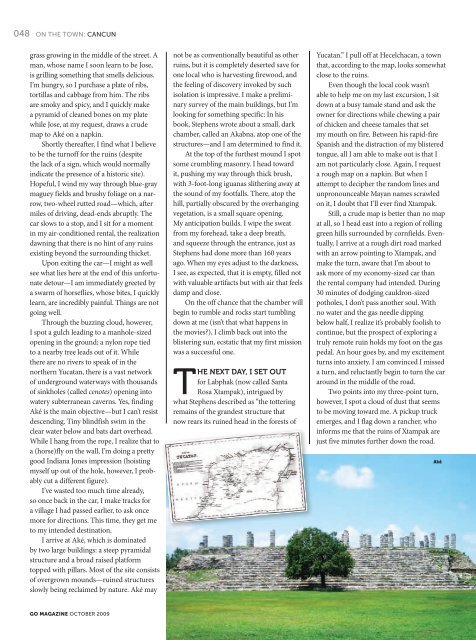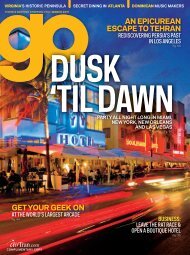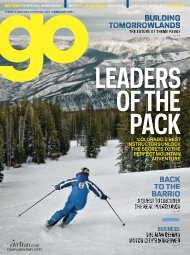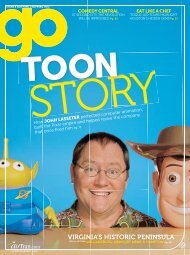You also want an ePaper? Increase the reach of your titles
YUMPU automatically turns print PDFs into web optimized ePapers that Google loves.
048<br />
ON THE TOWN: CANCUN<br />
grass growing in the middle of the street. A<br />
man, whose name I soon learn to be Jose,<br />
is grilling something that smells delicious.<br />
I’m hungry, so I purchase a plate of ribs,<br />
tortillas and cabbage from him. The ribs<br />
are smoky and spicy, and I quickly make<br />
a pyramid of cleaned bones on my plate<br />
while Jose, at my request, draws a crude<br />
map to Aké on a napkin.<br />
Shortly thereafter, I find what I believe<br />
to be the turnoff for the ruins (despite<br />
the lack of a sign, which would normally<br />
indicate the presence of a historic site).<br />
Hopeful, I wind my way through blue-gray<br />
maguey fields and brushy foliage on a narrow,<br />
two-wheel rutted road—which, after<br />
miles of driving, dead-ends abruptly. The<br />
car slows to a stop, and I sit for a moment<br />
in my air-conditioned rental, the realization<br />
dawning that there is no hint of any ruins<br />
existing beyond the surrounding thicket.<br />
Upon exiting the car—I might as well<br />
see what lies here at the end of this unfortunate<br />
detour—I am immediately greeted by<br />
a swarm of horseflies, whose bites, I quickly<br />
learn, are incredibly painful. Things are not<br />
going well.<br />
Through the buzzing cloud, however,<br />
I spot a gulch leading to a manhole-sized<br />
opening in the ground; a nylon rope tied<br />
to a nearby tree leads out of it. While<br />
there are no rivers to speak of in the<br />
northern Yucatan, there is a vast network<br />
of underground waterways with thousands<br />
of sinkholes (called cenotes) opening into<br />
watery subterranean caverns. Yes, finding<br />
Aké is the main objective—but I can’t resist<br />
descending. Tiny blindfish swim in the<br />
clear water below and bats dart overhead.<br />
While I hang from the rope, I realize that to<br />
a (horse)fly on the wall, I’m doing a pretty<br />
good Indiana Jones impression (hoisting<br />
myself up out of the hole, however, I probably<br />
cut a different figure).<br />
I’ve wasted too much time already,<br />
so once back in the car, I make tracks for<br />
a village I had passed earlier, to ask once<br />
more for directions. This time, they get me<br />
to my intended destination.<br />
I arrive at Aké, which is dominated<br />
by two large buildings: a steep pyramidal<br />
structure and a broad raised platform<br />
topped with pillars. Most of the site consists<br />
of overgrown mounds—ruined structures<br />
slowly being reclaimed by nature. Aké may<br />
GO MAGAZINE OCTOBER <strong>2009</strong><br />
not be as conventionally beautiful as other<br />
ruins, but it is completely deserted save for<br />
one local who is harvesting firewood, and<br />
the feeling of discovery invoked by such<br />
isolation is impressive. I make a preliminary<br />
survey of the main buildings, but I’m<br />
looking for something specific: In his<br />
book, Stephens wrote about a small, dark<br />
chamber, called an Akabna, atop one of the<br />
structures—and I am determined to find it.<br />
At the top of the furthest mound I spot<br />
some crumbling masonry. I head toward<br />
it, pushing my way through thick brush,<br />
with 3-foot-long iguanas slithering away at<br />
the sound of my footfalls. There, atop the<br />
hill, partially obscured by the overhanging<br />
vegetation, is a small square opening.<br />
My anticipation builds. I wipe the sweat<br />
from my forehead, take a deep breath,<br />
and squeeze through the entrance, just as<br />
Stephens had done more than 160 years<br />
ago. When my eyes adjust to the darkness,<br />
I see, as expected, that it is empty, filled not<br />
with valuable artifacts but with air that feels<br />
damp and close.<br />
On the off chance that the chamber will<br />
begin to rumble and rocks start tumbling<br />
down at me (isn’t that what happens in<br />
the movies?), I climb back out into the<br />
blistering sun, ecstatic that my first mission<br />
was a successful one.<br />
THE NEXT DAY, I SET OUT<br />
for Labphak (now called Santa<br />
Rosa Xtampak), intrigued by<br />
what Stephens described as “the tottering<br />
remains of the grandest structure that<br />
now rears its ruined head in the forests of<br />
Yucatan.” I pull off at Hecelchacan, a town<br />
that, according to the map, looks somewhat<br />
close to the ruins.<br />
Even though the local cook wasn’t<br />
able to help me on my last excursion, I sit<br />
down at a busy tamale stand and ask the<br />
owner for directions while chewing a pair<br />
of chicken and cheese tamales that set<br />
my mouth on fire. Between his rapid-fire<br />
Spanish and the distraction of my blistered<br />
tongue, all I am able to make out is that I<br />
am not particularly close. Again, I request<br />
a rough map on a napkin. But when I<br />
attempt to decipher the random lines and<br />
unpronounceable Mayan names scrawled<br />
on it, I doubt that I’ll ever find Xtampak.<br />
Still, a crude map is better than no map<br />
at all, so I head east into a region of rolling<br />
green hills surrounded by cornfields. Eventually,<br />
I arrive at a rough dirt road marked<br />
with an arrow pointing to Xtampak, and<br />
make the turn, aware that I’m about to<br />
ask more of my economy-sized car than<br />
the rental company had intended. During<br />
30 minutes of dodging cauldron-sized<br />
potholes, I don’t pass another soul. With<br />
no water and the gas needle dipping<br />
below half, I realize it’s probably foolish to<br />
continue, but the prospect of exploring a<br />
truly remote ruin holds my foot on the gas<br />
pedal. An hour goes by, and my excitement<br />
turns into anxiety. I am convinced I missed<br />
a turn, and reluctantly begin to turn the car<br />
around in the middle of the road.<br />
Two points into my three-point turn,<br />
however, I spot a cloud of dust that seems<br />
to be moving toward me. A pickup truck<br />
emerges, and I flag down a rancher, who<br />
informs me that the ruins of Xtampak are<br />
just five minutes further down the road.<br />
Aké
















